steering Citroen C4 AIRCROSS 2014 1.G User Guide
[x] Cancel search | Manufacturer: CITROEN, Model Year: 2014, Model line: C4 AIRCROSS, Model: Citroen C4 AIRCROSS 2014 1.GPages: 368, PDF Size: 20.37 MB
Page 91 of 368
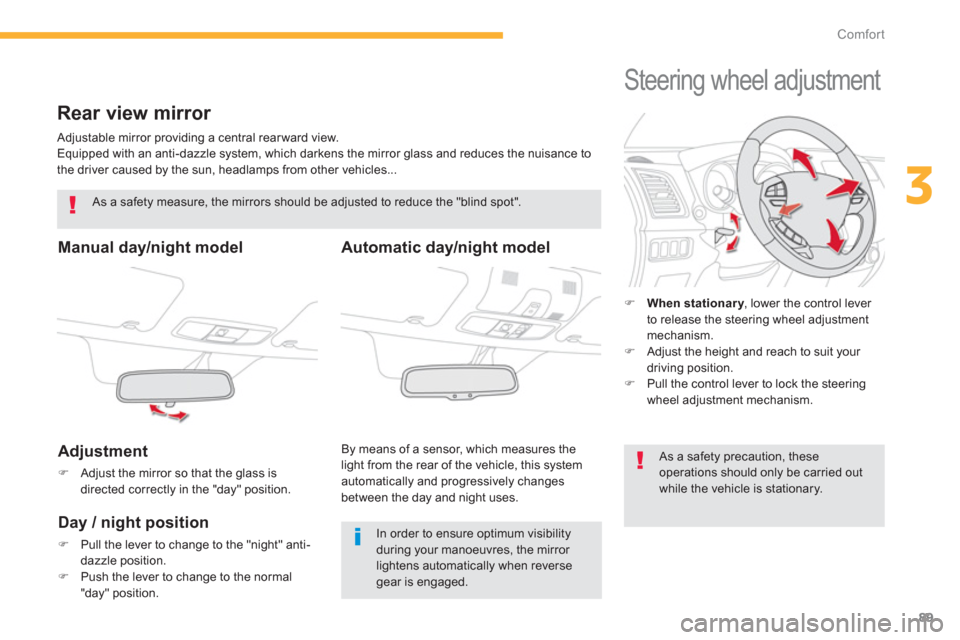
89
3
Comfort
Rear view mirror
Adjustable mirror providing a central rear ward view.
Equipped with an anti-dazzle system, which darkens the mirror glass and reduces the nuisance to
the driver caused by the sun, headlamps from other vehicles...
Manual day/night model
Adjustment
�)
Adjust the mirror so that the glass is
directed correctly in the "day" position.
As a safety measure, the mirrors should be adjusted to reduce the "blind spot".
In order to ensure optimum visibility
during your manoeuvres, the mirror
lightens automatically when reverse
gear is engaged.
Day / night position
�)
Pull the lever to change to the "night" anti-
dazzle position.
�)
Push the lever to change to the normal
"day" position.
Automatic day/night model
By means of a sensor, which measures the
light from the rear of the vehicle, this system
automatically and progressively changes
between the day and night uses.
Steering wheel adjustment
�)
When stationary
, lower the control lever
to release the steering wheel adjustment
mechanism.
�)
Adjust the height and reach to suit your
driving position.
�)
Pull the control lever to lock the steering
wheel adjustment mechanism.
As a safety precaution, these
operations should only be carried out
while the vehicle is stationary.
Page 106 of 368
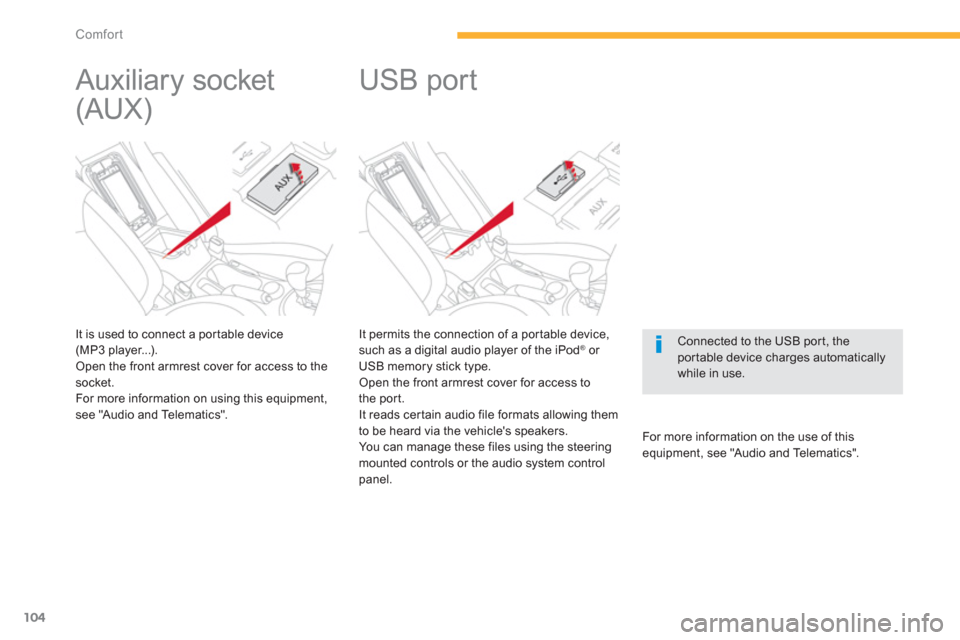
104
Comfort
It permits the connection of a portable device,
such as a digital audio player of the iPod ® or
USB memory stick type.
Open the front armrest cover for access to
the port.
It reads certain audio file formats allowing them
to be heard via the vehicle's speakers.
You can manage these files using the steering
mounted controls or the audio system control
panel.
For more information on the use of this
equipment, see "Audio and Telematics".
USB port
Connected to the USB port, the
portable device charges automatically
while in use.
Auxiliary socket
(AUX)
It is used to connect a portable device
(MP3 player...).
Open the front armrest cover for access to the
socket.
For more information on using this equipment,
see "Audio and Telematics".
Page 110 of 368
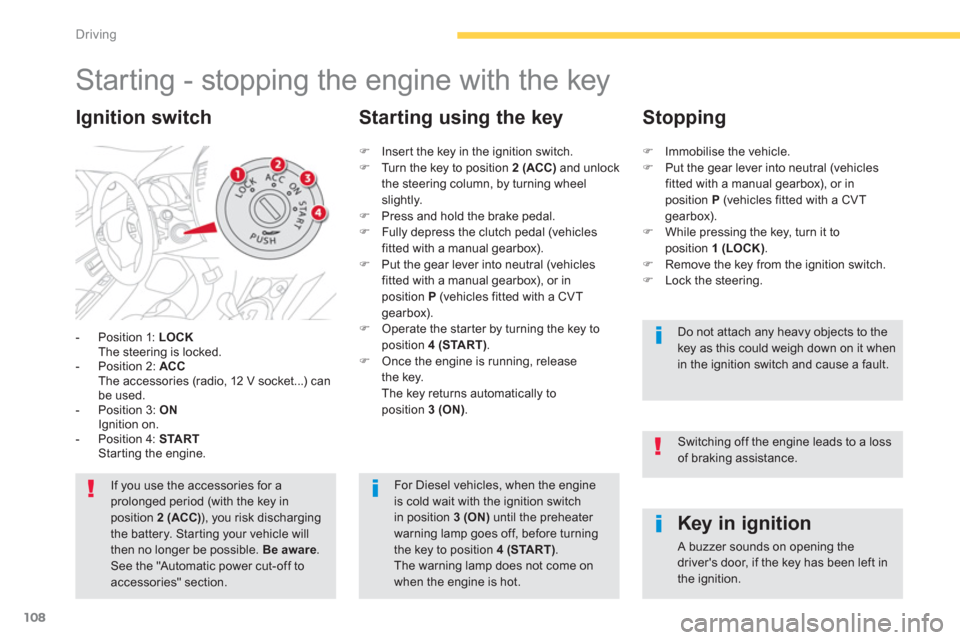
108
Driving
Starting - stopping the engine with the key
- Position 1: LOCK
The steering is locked.
- Position 2: ACC
The accessories (radio, 12 V socket...) can
be used.
- Position 3: ON
Ignition on.
- Position 4: START
Starting the engine.
Ignition switch
If you use the accessories for a
prolonged period (with the key in
position 2 (ACC)
), you risk discharging
the battery. Starting your vehicle will
then no longer be possible. Be aware
.
See the "Automatic power cut-off to
accessories" section.
Key in ignition
A buzzer sounds on opening the
driver's door, if the key has been left in
the ignition.
�)
Insert the key in the ignition switch.
�)
Turn the key to position 2 (ACC)
and unlock
the steering column, by turning wheel
slightly.
�)
Press and hold the brake pedal.
�)
Fully depress the clutch pedal (vehicles
fitted with a manual gearbox).
�)
Put the gear lever into neutral (vehicles
fitted with a manual gearbox), or in
position P
(vehicles fitted with a CVT
gearbox).
�)
Operate the starter by turning the key to
position 4 (START)
.
�)
Once the engine is running, release
the key.
The key returns automatically to
position 3 (ON)
.
Starting using the key
Stopping
�)
Immobilise the vehicle.
�)
Put the gear lever into neutral (vehicles
fitted with a manual gearbox), or in
position P
(vehicles fitted with a CVT
gearbox).
�)
While pressing the key, turn it to
position 1 (LOCK)
.
�)
Remove the key from the ignition switch.
�)
Lock the steering.
Do not attach any heavy objects to the
key as this could weigh down on it when
in the ignition switch and cause a fault.
For Diesel vehicles, when the engine
is cold wait with the ignition switch
in position 3 (ON)
until the preheater
warning lamp goes off, before turning
the key to position 4 (START)
.
The warning lamp does not come on
when the engine is hot.
Switching off the engine leads to a loss
of braking assistance.
Page 112 of 368
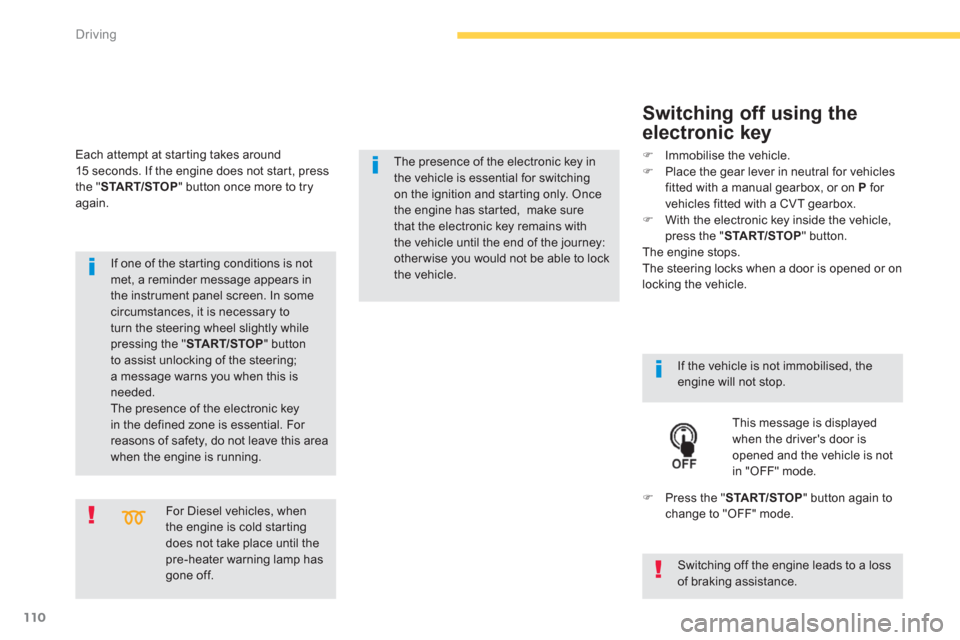
110
Driving
For Diesel vehicles, when
the engine is cold starting
does not take place until the
pre-heater warning lamp has
gone off.
If one of the starting conditions is not
met, a reminder message appears in
the instrument panel screen. In some
circumstances, it is necessary to
turn the steering wheel slightly while
pressing the " START/STOP
" button
to assist unlocking of the steering;
a message warns you when this is
needed.
The presence of the electronic key
in the defined zone is essential. For
reasons of safety, do not leave this area
when the engine is running.
Switching off using the
electronic key
If the vehicle is not immobilised, the
engine will not stop.
This message is displayed
when the driver's door is
opened and the vehicle is not
in "OFF" mode.
�)
Press the " START/STOP
" button again to
change to "OFF" mode.
�)
Immobilise the vehicle.
�)
Place the gear lever in neutral for vehicles
fitted with a manual gearbox , or on P
for
vehicles fitted with a CVT gearbox .
�)
With the electronic key inside the vehicle,
press the " START/STOP
" button.
The engine stops.
The steering locks when a door is opened or on
locking the vehicle.
Each attempt at starting takes around
15 seconds. If the engine does not start, press
the " START/STOP
" button once more to try
again.
The presence of the electronic key in
the vehicle is essential for switching
on the ignition and starting only. Once
the engine has started, make sure
that the electronic key remains with
the vehicle until the end of the journey:
other wise you would not be able to lock
the vehicle.
Switching off the engine leads to a loss
of braking assistance.
Page 113 of 368
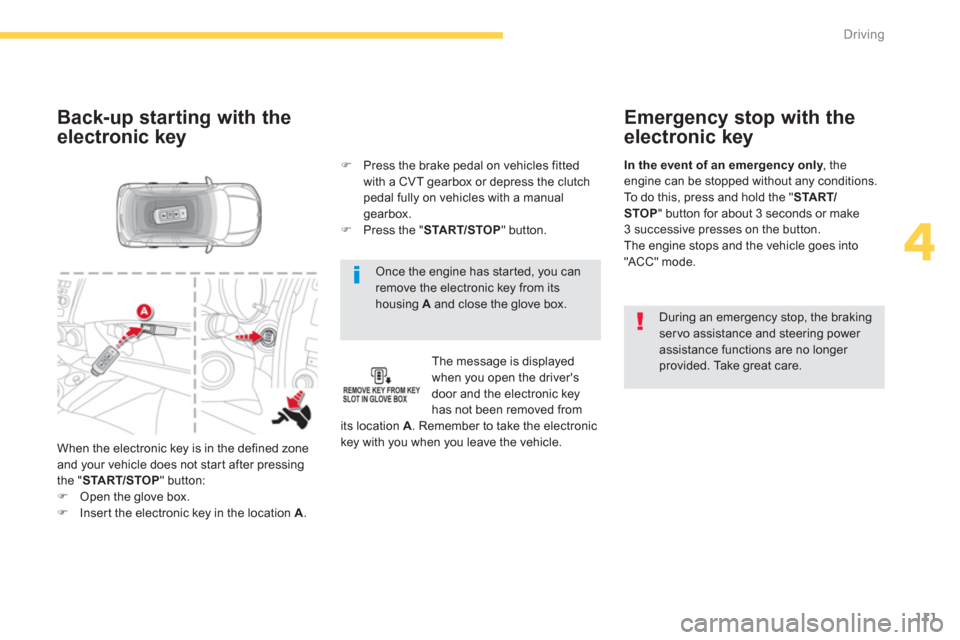
111
4
Driving
Once the engine has started, you can
remove the electronic key from its
housing A
and close the glove box.
Back-up starting with the
electronic key
The message is displayed
when you open the driver's
door and the electronic key
has not been removed from
its location A
. Remember to take the electronic
key with you when you leave the vehicle.
�)
Press the brake pedal on vehicles fitted
with a CVT gearbox or depress the clutch
pedal fully on vehicles with a manual
gearbox.
�)
Press the " START/STOP
" button.
When the electronic key is in the defined zone
and your vehicle does not start after pressing
the " START/STOP
" button:
�)
Open the glove box.
�)
Insert the electronic key in the location A
.
Emergency stop with the
electronic key
During an emergency stop, the braking
servo assistance and steering power
assistance functions are no longer
provided. Take great care.
In the event of an emergency only
, the
engine can be stopped without any conditions.
To do this, press and hold the " START/
STOP
" button for about 3 seconds or make
3 successive presses on the button.
The engine stops and the vehicle goes into
"ACC" mode.
Page 117 of 368

115
4
Driving
This gearbox has two driving modes:
- an automated mode for automatic control
of the gears by the gearbox and therefore
without any action on the part of the driver,
- a manual mode for sequential changing of
the gears by the driver using the steering
mounted controls or the gear lever.
CVT gearbox
It includes the following controls:
- a gear lever 1
on the centre console for
selecting the driving mode, reverse gear
and neutral or for changing gear in manual
mode,
- a "-"
steering mounted control paddle 2
for
manual downward gear changes,
- a "+/OFF"
steering mounted control
paddle 3
for manual upward gear changes.
The six-speed automatic gearbox offers a choice between the comfort of automatic regulation or the pleasure of manual gear changing.
The mode can be changed at any time.
Page 118 of 368
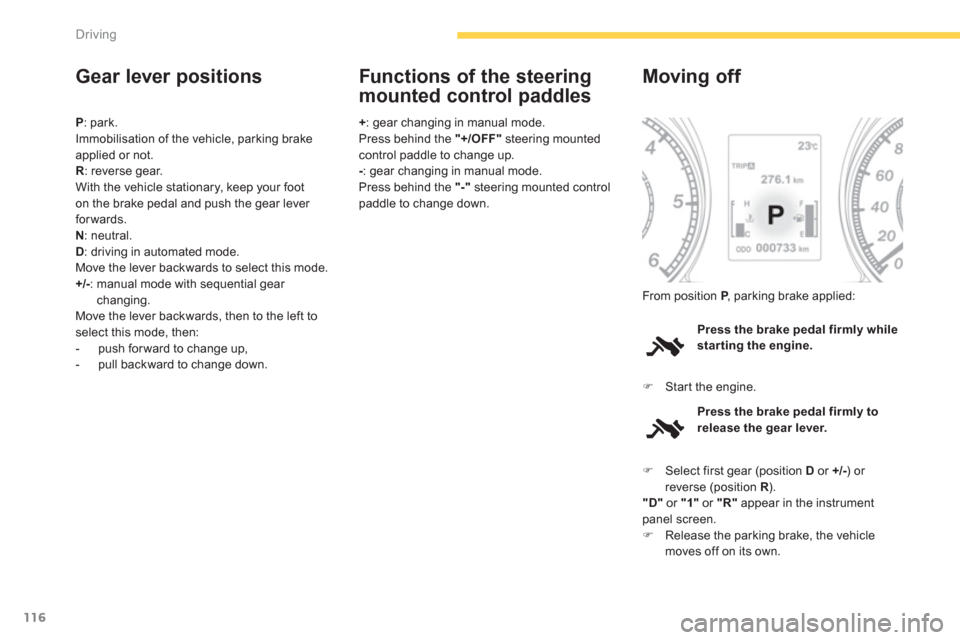
116
Driving
Gear lever positions
P
: park.
Immobilisation of the vehicle, parking brake
applied or not.
R
: reverse gear.
With the vehicle stationary, keep your foot
on the brake pedal and push the gear lever
forwards.
N
: neutral.
D
: driving in automated mode.
Move the lever backwards to select this mode.
+/-
: manual mode with sequential gear
changing.
Move the lever backwards, then to the left to
select this mode, then:
- push for ward to change up,
- pull backward to change down.
+
: gear changing in manual mode.
Press behind the "+/OFF"
steering mounted
control paddle to change up.
-
: gear changing in manual mode.
Press behind the "-"
steering mounted control
paddle to change down.
Functions of the steering
mounted control paddles
Press the brake pedal firmly while
star ting the engine.
Moving off
�)
Start the engine. From position P
, parking brake applied:
Press the brake pedal firmly to
release the gear lever.
�)
Select first gear (position D
or +/-
) or
reverse (position R
).
"D"
or "1"
or "R"
appear in the instrument
panel screen.
�)
Release the parking brake, the vehicle
moves off on its own.
Page 119 of 368
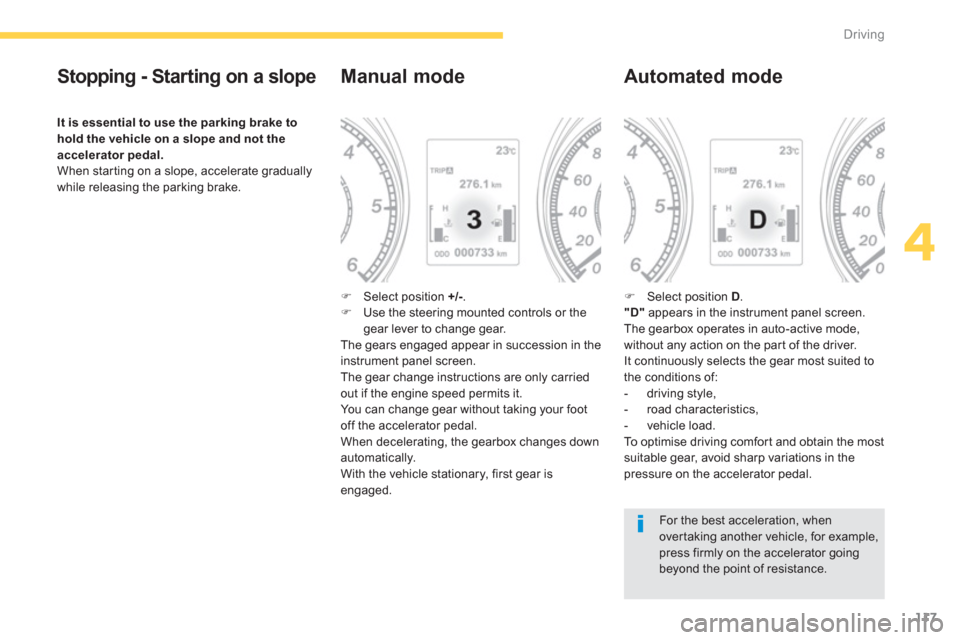
117
4
Driving
Stopping - Starting on a slope
It is essential to use the parking brake to
hold the vehicle on a slope and not the
accelerator pedal.
When starting on a slope, accelerate gradually
while releasing the parking brake.
Manual mode
�)
Select position +/-
.
�)
Use the steering mounted controls or the
gear lever to change gear.
The gears engaged appear in succession in the
instrument panel screen.
The gear change instructions are only carried
out if the engine speed permits it.
You can change gear without taking your foot
off the accelerator pedal.
When decelerating, the gearbox changes down
automatically.
With the vehicle stationary, first gear is
engaged.
Automated mode
�)
Select position D
.
"D"
appears in the instrument panel screen.
The gearbox operates in auto-active mode,
without any action on the part of the driver.
It continuously selects the gear most suited to
the conditions of:
- driving style,
- road characteristics,
- vehicle load.
To optimise driving comfort and obtain the most
suitable gear, avoid sharp variations in the
pressure on the accelerator pedal.
For the best acceleration, when
overtaking another vehicle, for example,
press firmly on the accelerator going
beyond the point of resistance.
Page 120 of 368
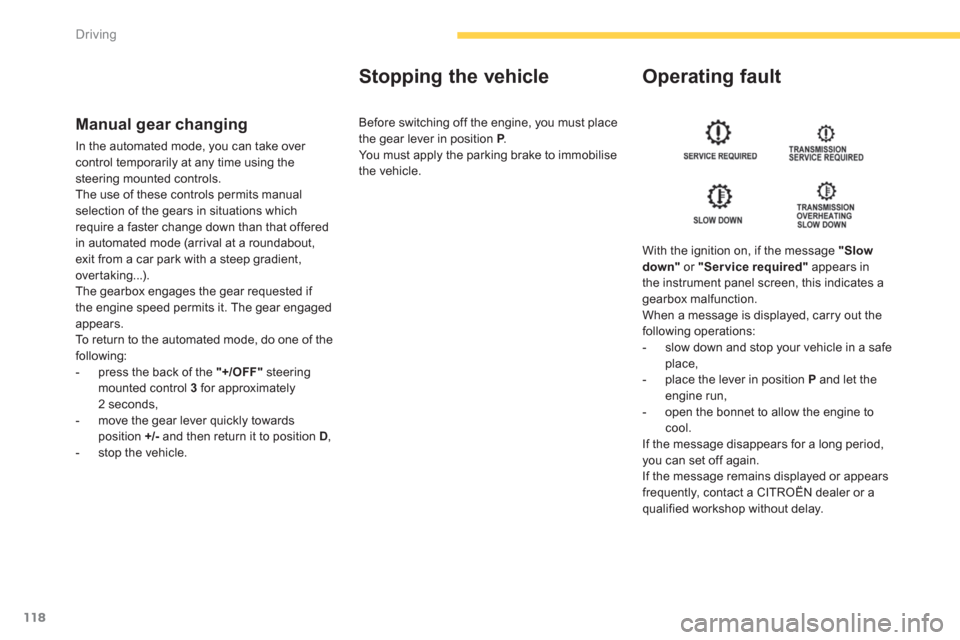
118Driving
Manual gear changing
In the automated mode, you can take over
control temporarily at any time using the
steering mounted controls.
The use of these controls permits manual
selection of the gears in situations which
require a faster change down than that offered
in automated mode (arrival at a roundabout,
exit from a car park with a steep gradient,
over taking...).
The gearbox engages the gear requested if
the engine speed permits it. The gear engaged
appears.
To return to the automated mode, do one of the
following:
- press the back of the "+/OFF"
steering
mounted control 3
for approximately
2 seconds,
- move the gear lever quickly towards
position +/-
and then return it to position D
,
- stop the vehicle.
Stopping the vehicle
Operating fault
With the ignition on, if the message "Slow
down"
or "Service required"
appears in
the instrument panel screen, this indicates a
gearbox malfunction.
When a message is displayed, carry out the
following operations:
- slow down and stop your vehicle in a safe
place,
- place the lever in position P
and let the
engine run,
- open the bonnet to allow the engine to
cool.
If the message disappears for a long period,
you can set off again.
If the message remains displayed or appears
frequently, contact a CITROËN dealer or a
qualified workshop without delay. Before switching off the engine, you must place
the gear lever in position P
.
You must apply the parking brake to immobilise
the vehicle.
Page 123 of 368
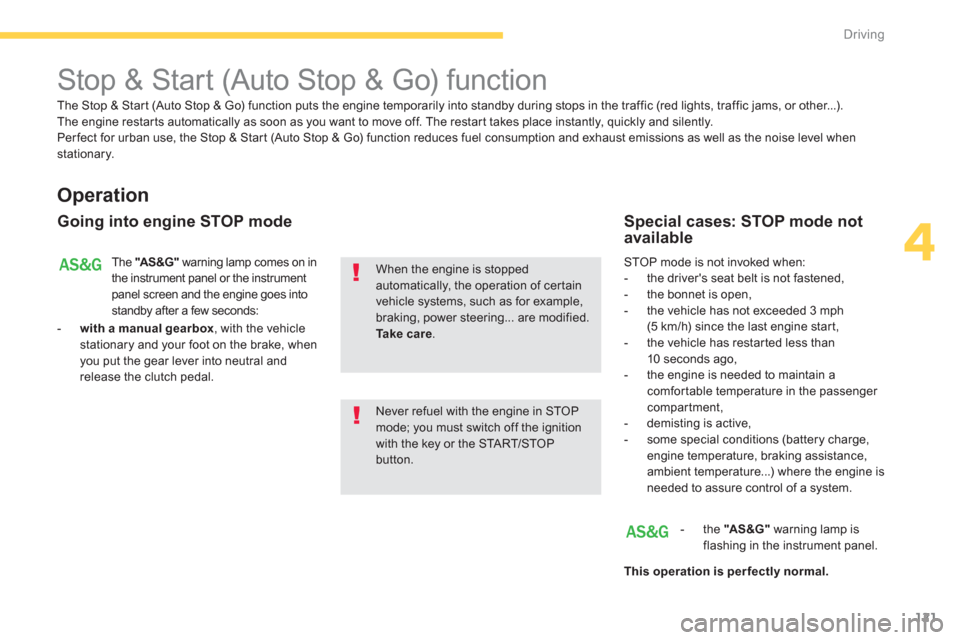
121
4
Driving
Stop & Start (Auto Stop & Go) function
Operation
Going into engine STOP mode
The "AS &G"
warning lamp comes on in
the instrument panel or the instrument
panel screen and the engine goes into
standby after a few seconds:
- with a manual gearbox
, with the vehicle
stationary and your foot on the brake, when
you put the gear lever into neutral and
release the clutch pedal.
Never refuel with the engine in STOP
mode; you must switch off the ignition
with the key or the START/STOP
button.
When the engine is stopped
automatically, the operation of certain
vehicle systems, such as for example,
braking, power steering... are modified.
Ta k e c a r e
.
Special cases: STOP mode not
available
STOP mode is not invoked when:
- the driver's seat belt is not fastened,
- the bonnet is open,
- the vehicle has not exceeded 3 mph
(5 km/h) since the last engine start,
- the vehicle has restarted less than
10 seconds ago,
- the engine is needed to maintain a
comfortable temperature in the passenger
compartment,
- demisting is active,
- some special conditions (battery charge,
engine temperature, braking assistance,
ambient temperature...) where the engine is
needed to assure control of a system.
- the "AS &G"
warning lamp is
flashing in the instrument panel.
This operation is per fectly normal.
The Stop & Start (Auto Stop & Go) function puts the engine temporarily into standby during stops in the traffic (red lights, traffic jams, or other...).
The engine restarts automatically as soon as you want to move off. The restart takes place instantly, quickly and silently.
Per fect for urban use, the Stop & Start (Auto Stop & Go) function reduces fuel consumption and exhaust emissions as well as the noise level when
stationary.